If you want to learn SEO copywriting, this is the guide for you. Higher rankings, more traffic, and a bigger bottom line await!
Specifically, this article will cover:
- What is SEO copywriting?
- 7 advanced SEO copywriting tips & best practices
- SEO copywriting examples
Let’s dive in!
What Is SEO Copywriting?
SEO copywriting is the art of crafting your content in a way that appeals to humans AND search engine robots. Click To Tweet
It’s knowing how to include your keywords naturally – so that it’s appealing to read, entices your readers to scroll further down the page, and doesn’t earn a penalty from Google.
For example, in the beginning of this article I used short sentences and an enticing value proposition that also included my keyword: “SEO copywriting”. That’s just one of the cool tips you’ll learn in this guide!
I’ve spent the last five years as a copywriter and SEO consultant, so I’ve discovered a thing or two about blending the fields together. You’re about to learn all my copywriting secrets!
7 Advanced SEO Copywriting Tips & Best Practices
The following simple SEO copywriting tips work for every business, no matter the industry or customer. I’ve used them across e-commerce stores, agencies, SaaS companies and even on our RV blog – and they work like a charm every time.
Here’s a quick overview of all the tips before we begin:
Now let’s get to it!
Further Reading:
1) Start with Knowing Your Audience
All good copywriting starts with a buyer persona.
A buyer persona is a document of a fictitious person based on market research. It reveals information on your target audience, such as their age, gender, interests, hobbies, pain points, etc.
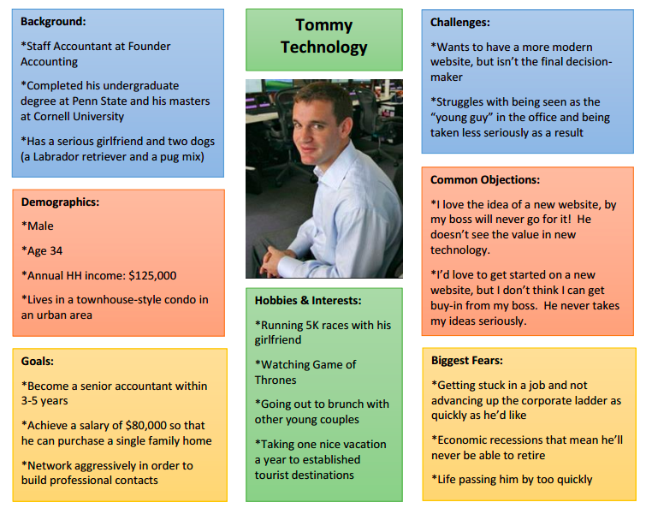
This is important because it helps you understand who you’re talking to and what their desires, goals and fears are (so you can dial up their pain points and get them to take action on whatever you’re writing about).
One of my favorite “shortcuts” to full-blown market research is browsing forums. Dedicated forums are great places to see exactly what people are struggling with, and even the words they’re using to describe these pains and hopes.
For example, take a look at the wording in this post:
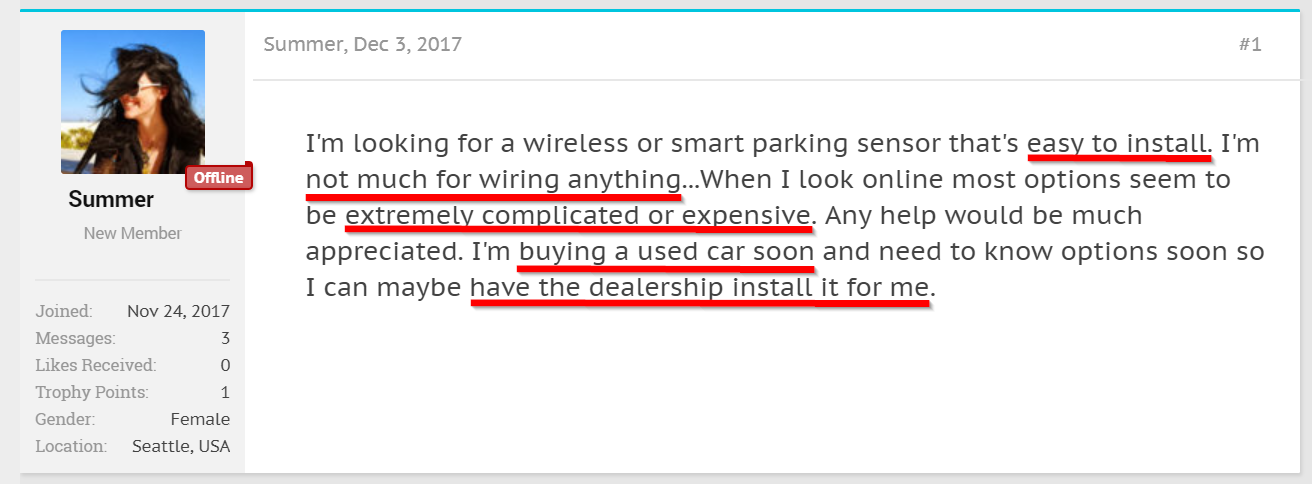
Based on this post, I might write an article or create a wireless parking sensor landing page that started out like this:
“Looking for a wireless smart parking sensor that’s easy to install?
You’ve come to the right place!
Our wiziwig parking sensors are neither complicated nor expensive. Even if you’re not much for wiring anything, you could install these in a snap!
Or just have your dealership install it for you when you purchase it. It’s so easy, anyone can do it!”
See how that works? Now you’re speaking your customer’s language!
If you need help finding forums, just Google “[your keyword] forums” or take a look on Find a Forum.
2) Use These Simple Headline Tricks to Get More Clicks
Businesses make up to $1 million more every year by investing in better headlines.*
*This is totally made up. But it got your attention, didn’t it?
Headlines are the secret sauce to getting more clicks, shares, and (ultimately) sales. So how do you make your headlines more compelling in search engines? According to BuzzSumo’s study of over 100 million headlines, here are the keys:
- Try to include a number in your headline. Headlines with numbers tend to get more clicks in the SERPs. The highest engagement rate on Facebook were headlines that began with: numbers 10, 5, 15 and 7.
- Posts with twelve to eighteen words in the headline receive the highest number of Facebook engagements on average.
- Phrases like “the future of”, “X ways to” and “need to know” got the highest engagement for B2B companies. B2C worked well with phrases like “this is what”, “X reasons why”, and “X things to”.
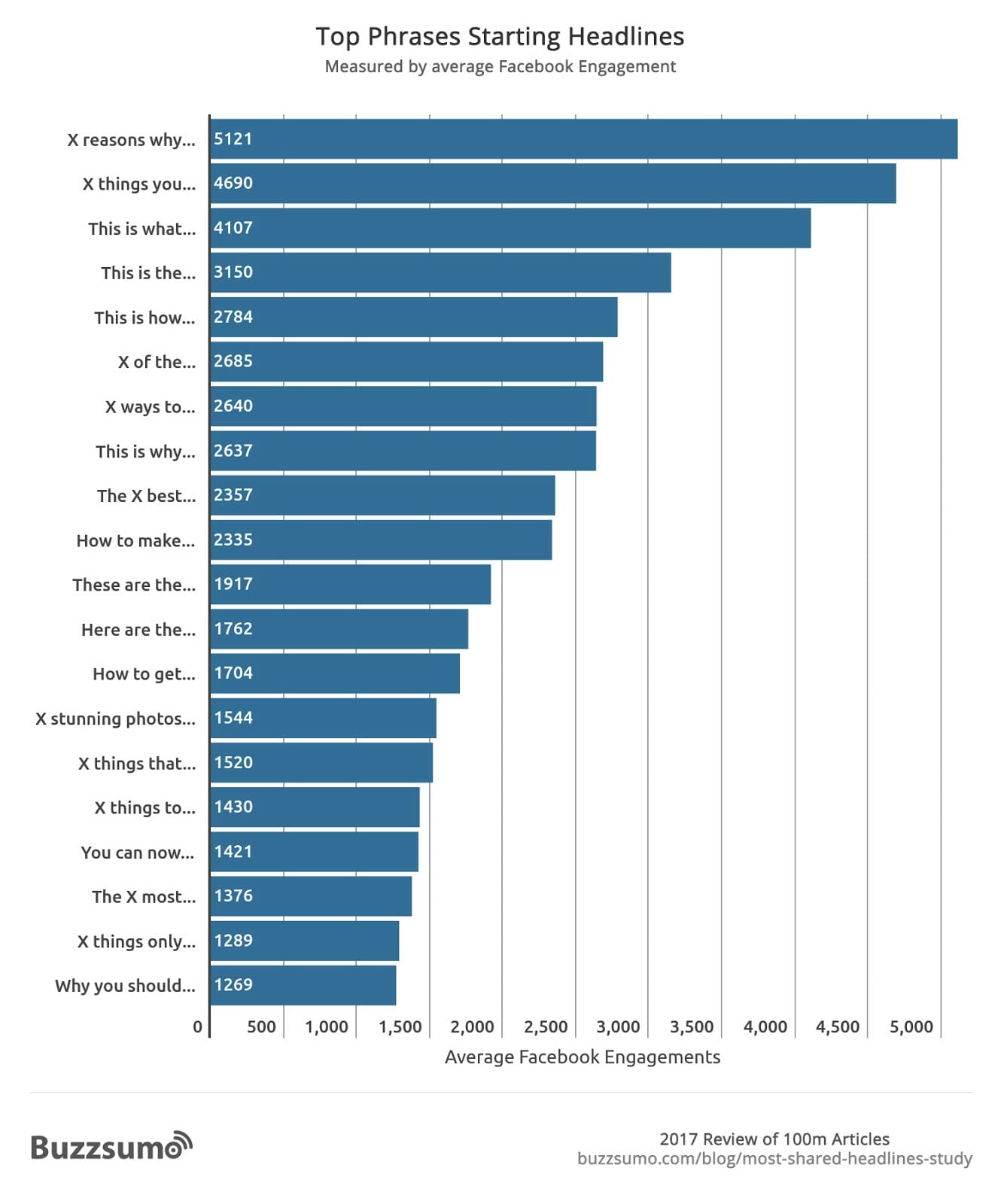
Besides numbers and phrases, you should also strive to use headline formulas that have been proven to work well. For example, how-to and list posts are some of the most popular articles on the Internet.
3) Craft a Compelling Intro that Leaves the Reader Wanting More
About 80% of people will read your headline, but only 20% will read the rest of your content. So if your headline has done its job, people will click to read the whole article. But you’re not done yet!
After your headline, your introduction to the article is extremely important for engaging your readers enough to ensure that they don’t leave. If the intro is vague, unclear, written poorly or too long, you’ll lose that 20% who opened your article. Luckily, writing an enticing intro is pretty easy.
Just use the APP method: Agree, Promise, Preview.
In other words, start your article by getting the reader to agree with something you’re saying. For example, in my guide on how to start a blog, I start the article like this:
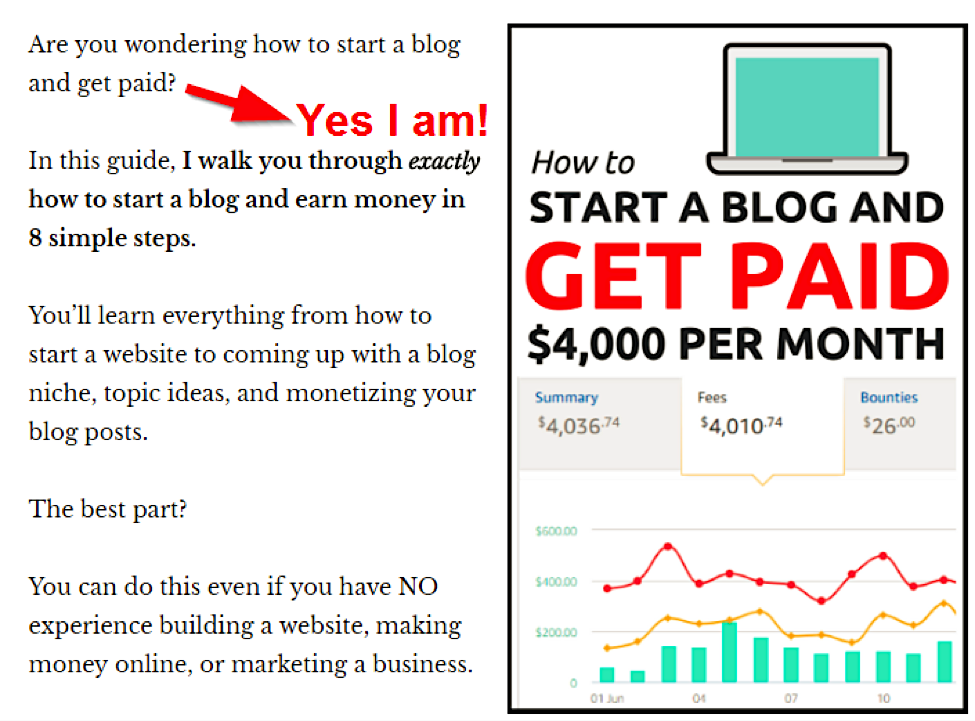
Immediately, I get my readers to say “yes”.
Following that, I make a simple promise: I’ll walk you through how to start a blog and earn money.
Your promise can be this simple, or it can be a bit more complex, such as promising they’ll learn something valuable for their business or how to achieve a certain task. I further make the promise that the reader will “learn everything from how to start a website to coming up with a blog niche, etc.”
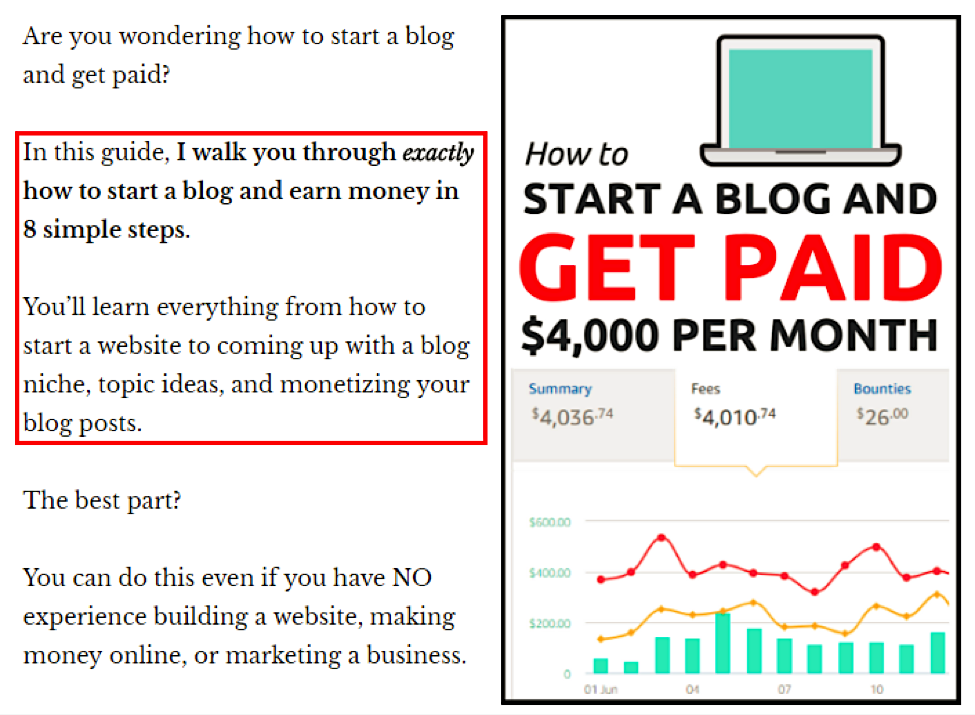
Once you’ve got your reader nodding in agreement and have made a promise to them that the article is worth their time, you must end with a preview of what they’re about to get.
If we scroll down, you can see how I did this in my article. I showed them a preview of the traffic numbers and how I outranked Amazon for a highly competitive keyword.
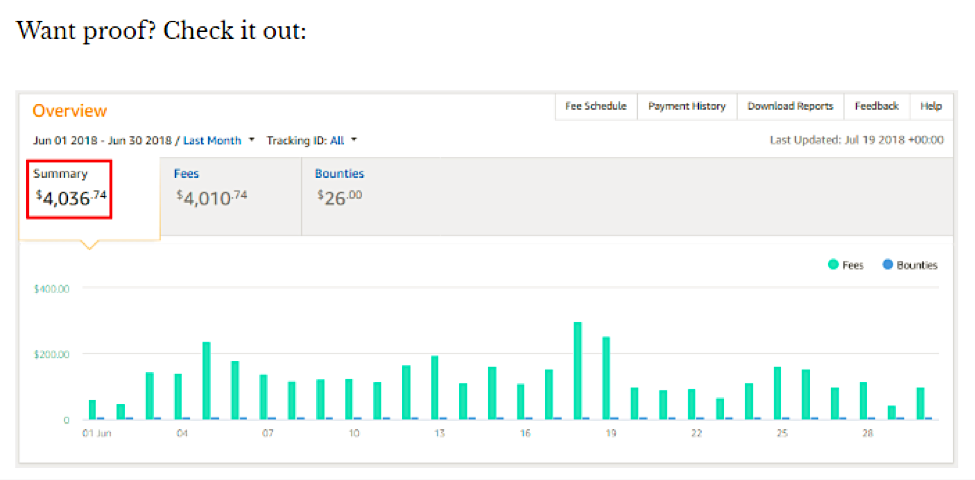
You’ll also notice that all the sentences in my intro are very short, and I typically only place one sentence per line. The reason for this is two-fold:
- Big paragraphs look scary, especially on mobile, and tend to drive people away before they even get to the heart of your content.
- Short sentences are easier to read – which means more people will read them.
As famous advertising expert Joseph Sugarman explains in his book The AdWeek Copywriting Handbook, the purpose of the first sentence is to get your reader to read the second sentence. The purpose of your second sentence is to get them to read the third. The purpose of the third sentence? You get the idea.
More on short sentences and getting people to read the next lines of your content in SEO copywriting tip #5 on bucket brigades. For now, let’s move on to:
Further Reading:
4) Break Up Your Content with Ridiculously Compelling Headings
You already know that your article’s title is important. But what about your section titles – or headlines?
If you’re not already, you should be using headings and subheadings to break up your content. In fact, I always start every article I write with a solid outline that includes all the headings.
Here’s a quick video on how I outline my blog posts:
Not any old heading will do, though! While it’s usually better to be clear rather than clever, some copywriting in your section headings can increase the readers’ time on page and improve your rankings.
For example, look at the headings I’ve created here. This section could have been called “write good headings”. But instead I called it “Break up your content with ridiculously compelling headings”. Which sounds better to you?
Another example would be using actual number results in your headings. For example, a great subheading might be “Use this SEO copywriting secret to increase time on page by 2 minutes”, followed by a strategy with a case study or proof to back it up.
You’ll find more SEO copywriting examples in the last section of this guide, but for now, let’s move on to the super secret copywriting strategy: bucket brigades!
5) Leverage “Bucket Brigades” to Turn Your Page into a Slippery Slope
I first learned of bucket brigades from legendary advertiser Joseph Sugarman. What’s a bucket brigade, you ask?
This is:
And so is this…
Oh, and there’s this!
Confused? Basically, a bucket brigade is a very short sentence or phrase that forces the reader to read the next line to get more context. If you look back through this article, you’ll notice I use them pretty frequently.
Some other bucket brigades you can use are:
- Here’s what you need to know:
- Wanna know how?
- Check this out:
- You’ll never believe this…
- WOW!
- You’re about to learn something amazing.
- Here:
- Like this:
By getting your reader to read just one more sentence…then one more sentence…then one more…you get them to “fall” down your article like a “slippery slope”, increasing your time on page and engagement rate.
6) Sprinkle in Media to Draw the Eye
Media isn’t exactly copywriting, but it’s still very important to search engine optimization copywriting.
Why? Because images and video done well can draw your reader’s eye to key points and takeaways, keep them interested (no one likes dense blocks of text), and increase their time on page – and thus, your rankings.
Plus, using high-quality images can help you rank on Google image search. Keep in mind that stock images may hurt your ranking (because people are unlikely to click on a stock photo that comes up in search results, Google Google images would lower the ranking of that image compared to other more appealing images.), meaning Google images would lower the ranking of that image compared to other more appealing images. ranked nor will the exact same picture from different websites or blogs be shown multiple times (just as duplicate content is penalized, so is duplicate images).
Some great SEO best practices for images in your posts include:
- Have a proper file name. “Image123.jpg” is no good. Instead, aim to include your primary or LSI keywords in your title. For example, I might name my images for this article “SEO-copywriting-tips”, “SEO-copywriting-examples”, or “B2C-copywriting-headlines”.
- Use proper alt text and titles on your images. Usually I make the alt text the same as the image file name, without the dashes. For the title, I just explain what the image is of, so if anyone hovers over it they can get some more info.
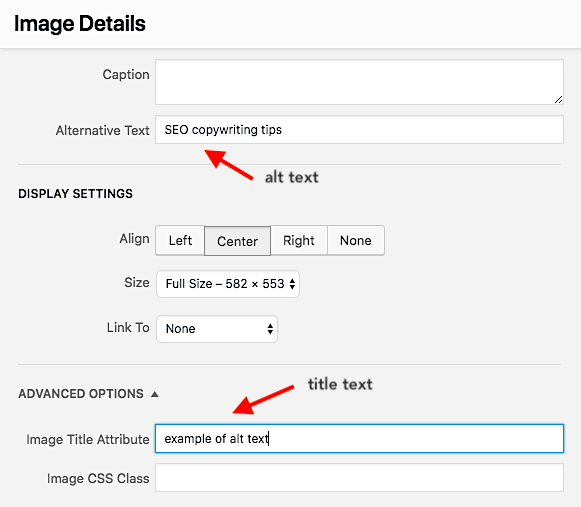
- Compress your images. This is important for page load speeds. Aim for less than 70kb per image file. You can use a tool like Gimp to do it for free.
But know this: not just any old image will do. Long gone are the days of stock images and random graphics that hold no value. Your images must be relevant to the article and of value to the reader.
Relevant images include:
- Screenshots explaining how to do something or illustrating your point
- Graphs, charts, and data that back up your point
- Infographics with useful data
Occasionally, high-quality stock images that relate to your content can work if you need something to break up long stretches of text, as long as they are interesting and creative. Before you download a stock photo, though, see if you can break up the text in other ways, like with bullet points, a video, a heading, a quote block, or a visual break of some kind every 150-300 words.
Further Reading:
7) Focus on Design to Instantly Build Trust with Your Readers
Just like images, your site’s design can boost dwell time and conversion rates – which in turn increases trust with your readers.
Here’s what I mean by design:
- Well-formatted content (short sentences and paragraphs, use of bullet points and bold or italics, high-quality images, appropriate headings and subheadings, etc.)
- Minimum of 14px font (preferably 16px) for easy reading on screens
- Allowing appropriate white space and not stuffing too many things in one area
- Using no more than 2-3 main colors site-wide that pair well
- Using a font with good web-readability:
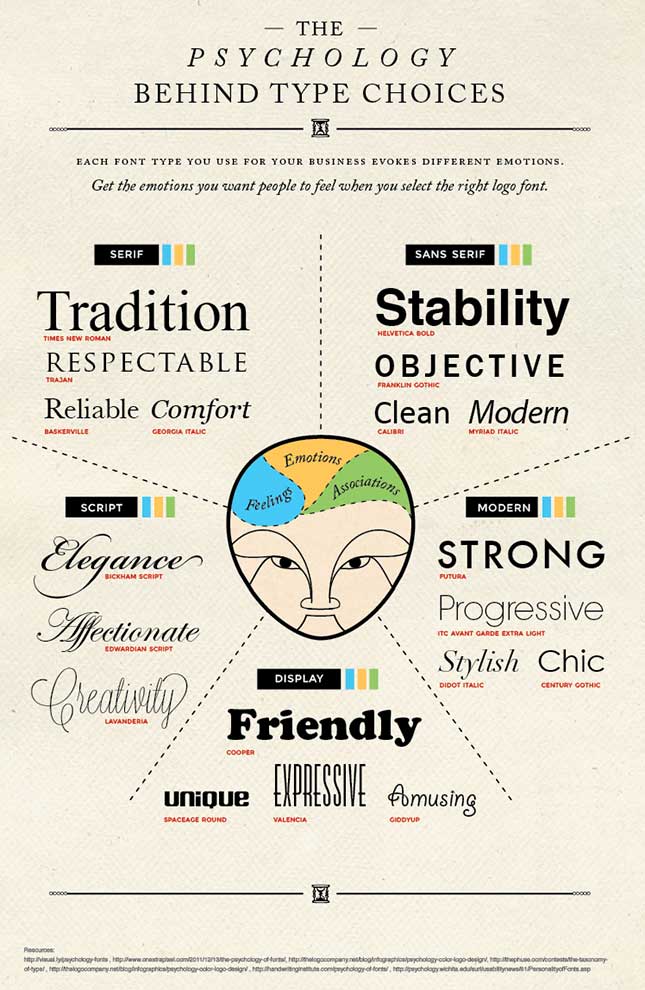
Want some examples? Keep reading!
SEO Copywriting Examples
In this section, I’ll share two SEO copywriting examples I thought were particularly powerful and interesting.
The first one is an example of bucket brigades and using humor, and the second is an example of great design combined with great copy.
1) Backlinko’s Guide to BuzzSumo
Backlinko is an SEO blog run by Brian Dean, a master of SEO copywriting. He recently released a guide to using BuzzSumo for content marketing:
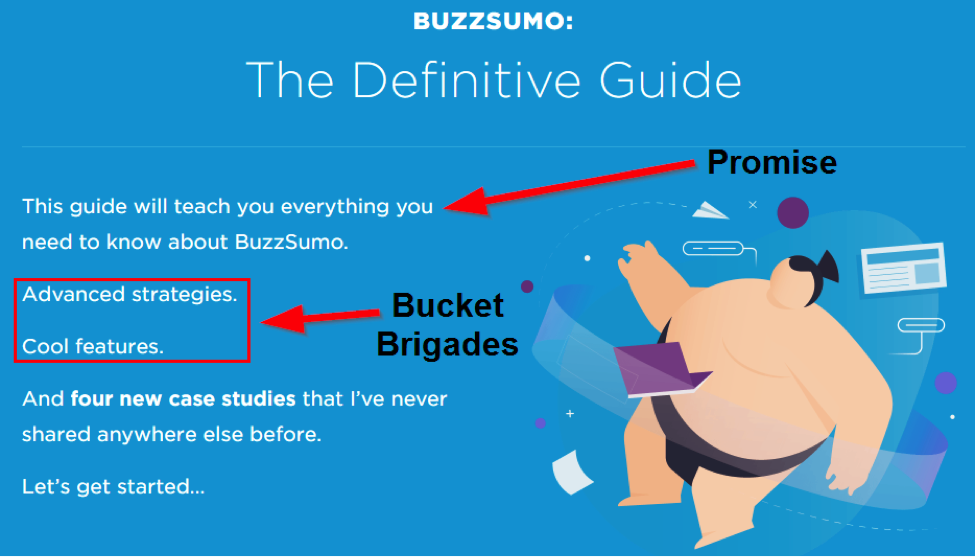
Brian uses a straight-to-the-point approach to get people hooked into the guide. He makes a promise and then uses bucket brigades to push you down the page. If you scroll through the guide, you’ll notice he uses almost every tip in this copywriting guide.
What can you learn?
- He builds immediate trust (and branding) through high-quality design.
- As soon as you scroll down, you get a well-designed table of contents, which helps the reader get to where they want to go and improves time on page.
- Each “chapter” has a summary which, like the opening to the guide, is right to the point, makes a promise of what you’ll get from reading, and uses bucket brigades.
- There are tons of screenshots to show you what he’s talking about. This makes the article easier and faster to read and comprehend.
- All of his section headings provide a direct benefit. You know exactly what you’ll get if you read those sections, and the benefit sounds so enticing you want to read it.
2) Water Pump Buyer’s Guide
I wrote an RV water pump buying guide that I’m particularly proud of, and think it’s a great example of the tips you’ve learned in this guide. (It’s also #4 on Google for “RV water pump”).
Check it out:
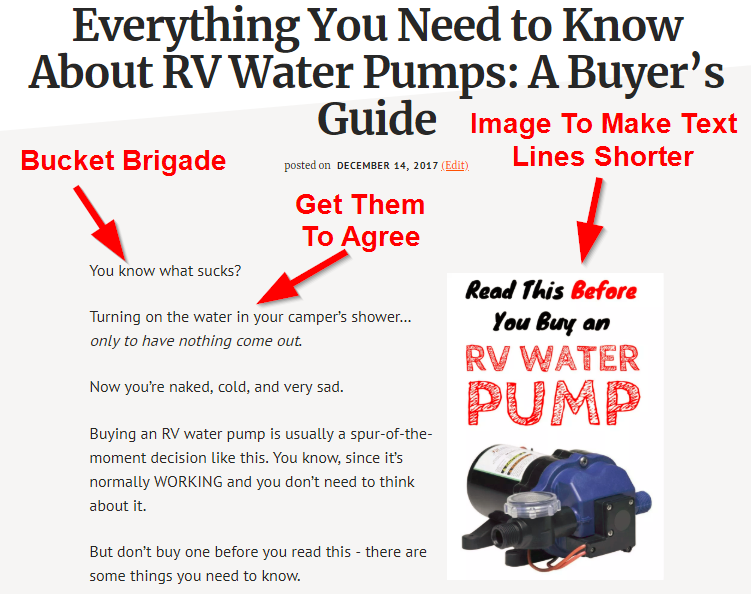
Here’s why it’s doing well:
- The design is minimal – I don’t have distracting sidebars or images around the title
- The image shortens the intro text, which improved readability
- It uses humor (“naked, cold, and very sad”)
- It opens with a bucket brigade
- It gets the reader to agree right away
Further Reading:
Improving Your Rankings with SEO Copywriting
If you followed this guide, you’re now familiar with seven of my favorite advanced SEO copywriting tips to improve your search rankings and increase your conversion rates.
While these strategies won’t rank your content overnight, they are sure to:
- Help you move up the first page of Google
- Improve dwell time and engagement rate
- Lower your bounce rate
- Become an overall better writer
Regardless of the industry you’re in, these are SEO copywriting tips for every business. Anyone can use them to improve their content overnight. Will you?